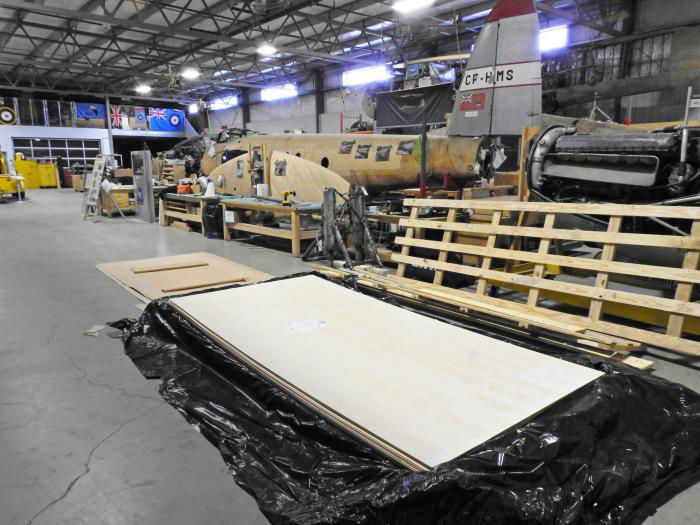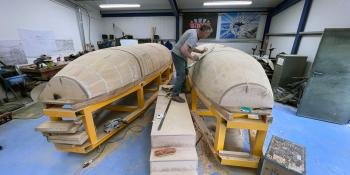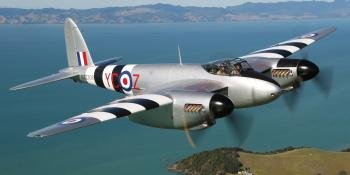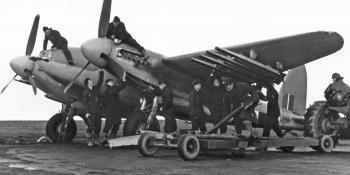Multi-national effort solves supply problem for Calgary museum ‘Mossie’ project

Following the Russian invasion of Ukraine in February, sourcing the correct British Standard 6V3 grade of plywood for de Havilland Mosquito restoration projects has become near-impossible, but in mid-October Richard de Boer and his team which is engaged in restoring Mosquito B35 RS700/CF-HMS for the Calgary Hangar Flight Museum managed to arrange a delivery of the plywood required to skin the wing of the former Spartan Air Services aerial survey machine.
The restoration is being carried out at the Bomber Command Museum of Canada at Nanton, 57 miles south of Calgary. Richard explains, “All British and Canadian-built Mosquitos used Baltic birch plywood made to 6V3. Part of what that means is that every sheet, regardless of its finished thickness, is comprised of just three layers or veneers. The plywood on the Mosquito varies in thickness from 1.5mm to 6mm. That means the veneers are custom-cut for thickness on each sheet. Where it gets even more complicated is that the grain direction is also specified by de Havilland for every sheet used on the aeroplane. In some places it's ‘normal’, meaning the grain of the two outer layers runs the length of the sheet; some run crosswise on the sheet and some run at a 45° angle. The grain direction was decided based on the structural stresses on each section of the airframe.
“Back in 2014 we contacted Mosquito airframe builder Glyn Powell in New Zealand to find out where he was getting his plywood. He sent us to the JAF Group in Austria. We purchased all the plywood necessary for the structural repairs on the fuselage and tail surfaces of CF-HMS. In September 2021, we called the North American rep for JAF to order 13 sheets of BS 6V3. No-one answered the phone. We tried the head office in Austria. No answer! Odd, as it is a multi-national company. Turns out they were on a COVID shut-down.
“It took until this spring before they opened up again. By then, JAF had a new North American rep. He said ‘no’ to our wood order, explaining that the birch required to manufacture the 6V3 came from Russia, and with the invasion of Ukraine it was not possible to source it. Thus began the hunt.
“I spoke to mills in Finland and Estonia, Canada and the United States. No-one made BS 6V3. They did make other aircraft-grade plywood, but the sheets were too small. They all cut their veneers to a standard 0.5mm, meaning 6mm-thick plywood was 12 layers not three, and 45° grain was virtually unavailable.
“For our annual Mosquito Day at the Bomber Command Museum in Nanton in late June, I used the Russia/Ukraine angle to get the Calgary Herald newspaper to do a story in advance of the event. It was a good day, and after the story came out I had over a dozen calls from suppliers, suggestions from well-intentioned readers, and offers from home-builders with spare plywood. No-one had 6V3. So I posted the Calgary Herald story on our Facebook page.
“Glyn Powell built the new Mosquito airframes in New Zealand and Avspecs in Auckland did all of the mechanical work on the bare airframes to create three new flying Mosquitos. Sadly Glyn died three years ago, but Warren Denholm, who owns and operates Avspecs, saw the story on Facebook and dropped me a line on Messenger saying he might be able to help us out. He offered to sell us some of his wood and he would reorder when he needed to replace it. I stupidly asked how he would get new wood with the Russia/Ukraine problem. Then Warren’s wood was no longer for sale. Warren and I continued to talk. Warren talked to JAF in Austria. He eventually got a ‘yes’ from JAF, who had found a new source for birch, and Warren quoted us a price. We paid it. Our plywood, a year after our first call, has now been delivered. Thank you, Warren. Thank you, JAF. Thank you, Facebook.”





